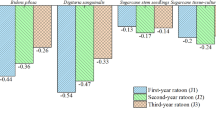Abstract
The major inhibitory components obtained after fractionation of an aqueous extract of field-grown sorghum (Sorghumbicolorcv. Bird-a-boo) herbage were quantified in terms of biological potency by indexing three aspects of cumulative cress (Lepidium sativum cv. Curlycress) seed germination. The inhibitory potential expressed in the crude aqueous extract reflected a complex interaction of numerous individual components of diverse chemical compositions and potencies. Some of these inhibitory components included chemical classes not previously associated with herbage phytotoxicity.
Similar content being viewed by others
References
Abdul-Wahab, A.S., andRice, E.L. 1967. Plant inhibition by Johnson grass and its possible significance in old-field succession.Bull. Torrey Bot. Club 94:486–497.
Conn, E.E., andAkazawa, T. 1958. Biosynthesis ofp-hydroxybenzaldehyde.Fed. Proc. 17:205.
Dunstan, W.R., andHenry, T.A. 1902. Cyanogenesis in plants. Part II. The great millet,Sorghum vulgare.Phil. Trans. R. Soc. (London). Ser. A 199:399–410.
Fieser, L.F., andWilliamson, K.L. 1975. Organic Experiments. D.C. Heath and Co., Lexington, Massachusetts, 406 pp.
Guenzi, W.D., andMcCalla, T.M. 1962. Inhibition of germination and seedling development by crop residues.Soil Sci. 26:456–458.
Guenzi, W.D., andMcCalla, T.M. 1966. Phenolic acids in oats, wheat, sorghum, and corn residues and their phytotoxicity,Agron. J. 58:303–304.
Guenzi, W.D., McCalla, T.M., andNorstadt, F.A. 1967. Presence and persistence of phytotoxic substances in wheat, oat, corn and sorghum residues.Agron. J. 59:163–165.
Kovacs, M.F., Jr. 1972. Dhurrin (p-hydroxymandelonitrile-B-d-glucoside): An allelopath identified in johnsongrass [Sorghum halepense (L.) Pers.] rhizome PhD dissertation, University of Maryland, College Park.
Lawrence, T., andKilcher, M.R. 1961. The effect of fourteen root extracts upon germination and seedling length of fifteen plant species.Can. J. Plant Sci. 42:308–313.
Lehle, F.R., andPutnam, A.R. 1982. Quantification of allelopathic potential of sorghum residues by novel indexing of Richards' function fitted to cumulative cress seed germination curves.Plant Physiol. 69:1212–1216.
Lehle, F. R.,Putnam, A. R., andLeavitt, R.A. 1983. Automated instrument for cumulative seed germination data collection and analysis.Seed Sci. Technol. Accepted for publication.
Martin, J.H., Couch, J.F., andBriese, R.R. 1938. Hydrocyanic acid content of different parts of the sorghum plant.J Am. Soc. Agron. 30:725–734.
Megie, C.A., Pearson, R.W., andHiltbold, A.E. 1966. Toxicity of decomposing crop residues to cotton germination and seedling growth.Agron. J. 59:197–199.
Robinson, B. 1977. SPSS subprogram NONLINEAR-nonlinear regression. Northwestern University Vogelback Computing Center Manual No. 433.
Author information
Authors and Affiliations
Additional information
Michigan Agric. Exp. Stn. Article No. 10714. Supported by USDA. SEA, Competitive Grant 78-59-2261-0-1-060-1 (to A. R. P.).
Rights and permissions
About this article
Cite this article
Lehle, F.R., Putnam, A.R. Allelopathic potential of sorghum (Sorghum bicolor). J Chem Ecol 9, 1223–1234 (1983). https://doi.org/10.1007/BF00982224
Received:
Revised:
Issue Date:
DOI: https://doi.org/10.1007/BF00982224




